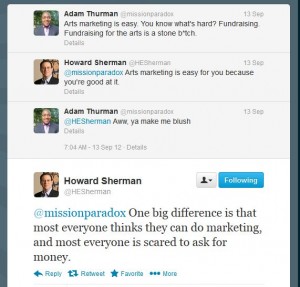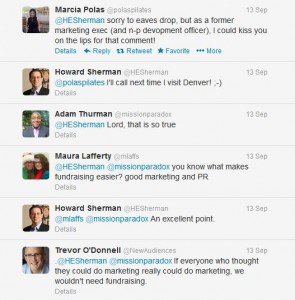If you are planning new building construction or a significant renovation, you would do well to check out the Set in Stone research project performed by the University of Chicago. When I first heard about the site and the research which looks at the construction of cultural arts facilities from 1994-2008, I thought it might be a thinly veiled indictment of overly-ambitious construction of arts centers.
But in fact there is far less failure reported than I expected, (though plenty of struggle), and the site is designed to be a resource for both research on the topic as well as guidance about the whole process. Prominently placed on the page is a six minute video that provides some quick advice about under taking a construction campaign.
Basically, it says people underestimate the project costs and over-estimate their ability to generate the revenue to operate the building upon completion. The video also notes that there are a lot of factors and constituencies with expectations contributing pressure to the project and suggests four questions to continually ask at all stages to keep things on track–or help ultimately decide to terminate the effort.
Four case studies illustrate the impact of these pressures on new facility construction. My favorite is the case study for the Art Institute of Chicago. It really provides some detailed insights into how the ambitions of the board, fundraisers and architect interacted to shape the construction of their new Modern Wing.
There is a quick overview of the study available but you may eventually want to take the time to read the full report. The full paper discusses construction and funding trends around the country and explores the impact of population shift and GDP on some of these trends.
There were some surprising and interesting situations they uncovered like the Pittsfield, MA metropolitan statistical area has the highest per capita spending on construction projects in the country, trailed by San Francisco; Appleton, WI; Madison, WI and Lawrence, KS. Who knew?
Interestingly, the construction during the boom period they researched didn’t seem to be in response to demand from the cultural sector.
This suggests that, in the boom period, increases in the supply of cultural facilities may not have responded to demand increases in the cultural sector. In fact, the evidence suggests that the relationships were negative during the boom period; either there was overinvestment in the supply of facilities relative to cultural sector demand for facilities, or facilities investment may have been responding to something else altogether.
What I also found interesting was that population size didn’t impact how much a city invested in the cultural infrastructure but rather how fast the population was increasing or decreasing. If the population started increasing, so did the investment in infrastructure.
What I found most informative was a comparison of the construction processes of different types of cultural organizations. There were assets and liabilities generally common to each type of cultural organization: producing theatres, museums, non-resident performing arts centers and resident performing arts centers.
Producing theatres seemed to have the easiest time with the process going from conception to completion in a relatively short time (7 years). Producing theatres were motivated to advance their mission and were able to keep that front and center throughout the process. They had the biggest cost overruns at 92% higher than the initial budget, (my emphasis)
“However, the starting budget was usually an internal figure and these projects’ managers were clever about when to announce their budgets publicly so that the escalations did not appear outrageous to the community. Interestingly, the publicly perceived escalations were often much lower—an average of about 19 percent. More importantly, the escalations that did occur often had a clear connection to organizational needs and were seen as helping the organization pursue its artistic mission.”
Museums also had a relatively short conception to completion time (about 9 years). One of the biggest challenges the report says they face is strong boards who often meddle with the plans often blurring a clear sense of leadership and leading to a fairly high rate of turnover on project boards. Cost overruns were only about 46% but were due to non-mission critical additions. Also museums were not able to be as flexible about generating revenue and often had to cut staffing and programming to deal with budget shortfalls.
The construction of Non-resident performing art centers were often strongly motivated by service to the community. (my emphasis)
“However, more often than not, community need for the nonresident PAC was not accurately determined. For example, a large majority of these projects used economic impact arguments as rationales for building. Included in these arguments was the implicit assumption that by building a cultural facility in a blighted area, it would automatically attract and sustain a substantial audience who would not otherwise have ventured there. Nine times out of ten, these assumptions were not accurately tested, and when the facility project was completed, the desired swarm of activity never materialized…Since the motivation for the project was so strongly centered in the desire to culturally enrich the broader community in a necessarily general way, a specific organizational artistic mission (if there was one) was often swept aside or obscured by a general enthusiasm for the idea of building a new arts facility for local residents.”
This situation resulted partially because these projects were organized by groups operating from a shared leadership model which meant there is often no clear stated central vision. Cost overruns of 62% were attributed to delays and lack of organization in the decision making process. Non-resident performing arts centers were generally flexible in their ability to absorb the overruns thanks to their low operating costs. Unfortunately, because most of the costs came from presenting performances, the preferred option to reducing expenses is usually to reduce programming.
Resident Performing Arts Centers have the hardest time getting started, mostly due to the need to serve the disparate requirements of multiple resident companies which often represent different arts disciplines. Because the founding organizations are often well-established, each with their own board of directors, a single clear, consistent leader is often difficult to identify.
These projects averaged 12 years from conception to completion, which doesn’t include the feasibility study period preceding the project proposal. Influence of the various groups can wax and wane quite a bit in that time. The constituent groups may be unwilling to cede authority even to the performing arts center executive once the facility begins operations. Changes in plans and leadership often means opening dates are frequently rescheduled.
“First, resident PACs were the costliest among all the different categories of projects. On average, they cost approximately $109 million to build and went about 64 percent over their initial proposed budgets. On a per seat basis, the median dollar per seat for resident PACs was $37,527, compared to $12,155 for nonresident PACs.”
The need to serve many resident organizations means that the resident PAC has less flexibility to use its spaces to generate additional revenue for the facility. Also, all the organizations are in the same boat together. If one organization faces a distressing situation, it impacts the future of all.
There were some other interesting observations that resulted from the study that I will address in a later entry. As I said, the Set In Stone site provides some pretty good resources and information to help you recognize and perhaps avoid problems others have faced with their major construction projects.




I've been to a few of the Science on Tap events, though I never gave a talk at one of…